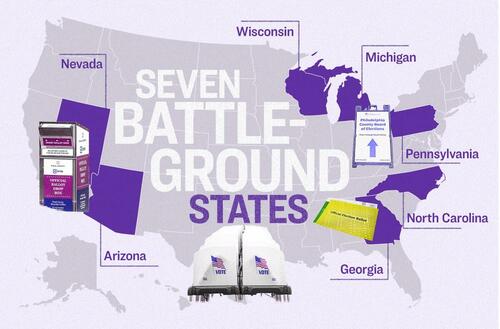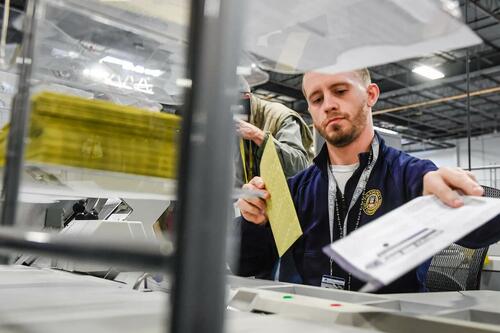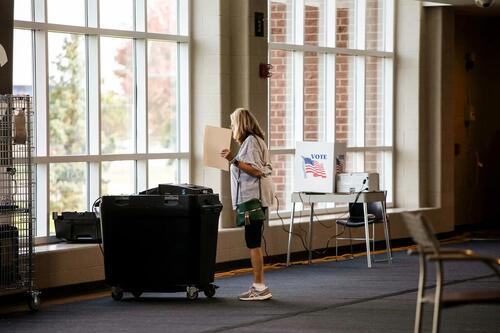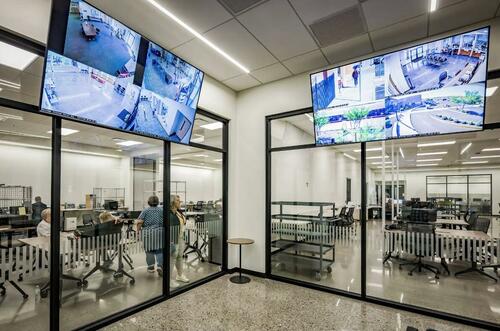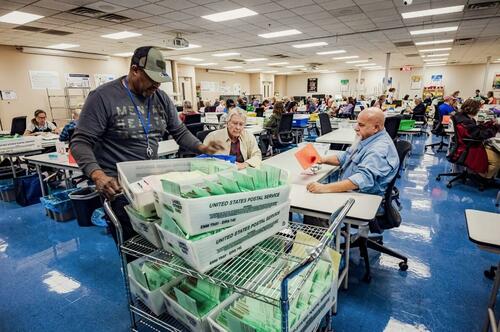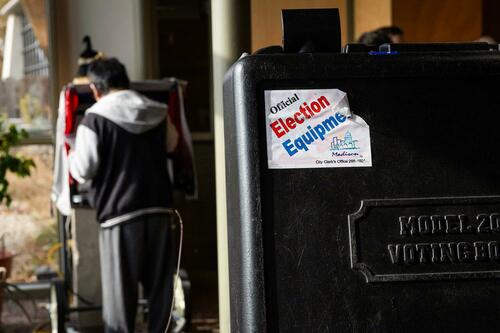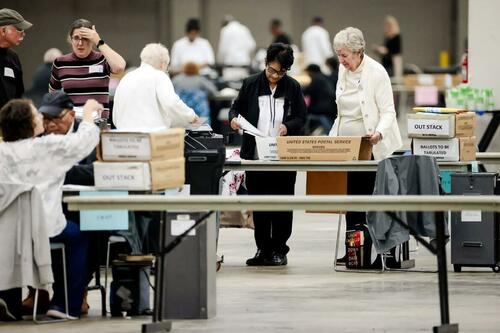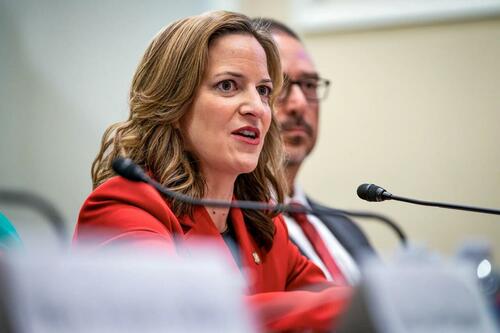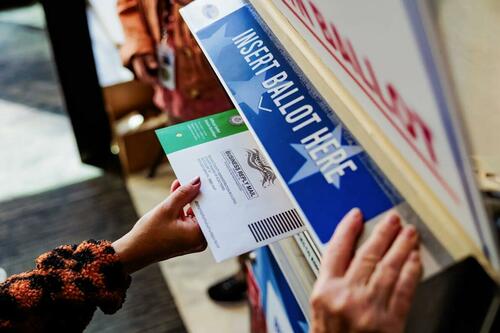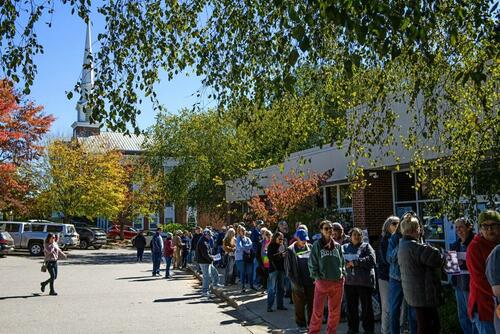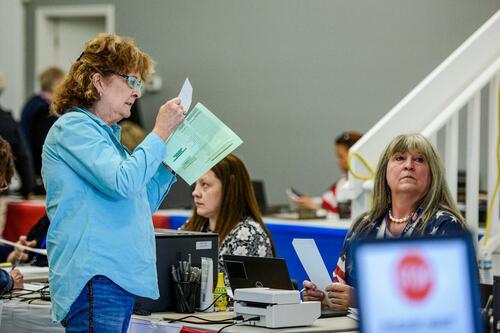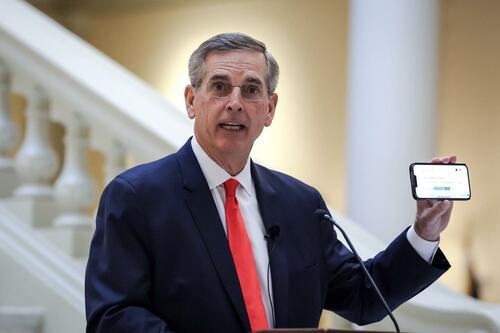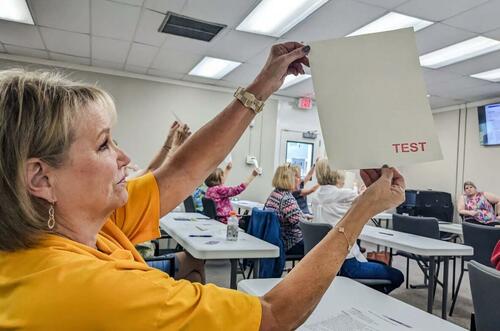How The 7 Swing States Will Count Votes And Post Election Results
The 2024 presidential election on Nov. 5 likely hinges on the outcome in seven battleground states.
Battlegrounds—also called swing or purple states—are where support for Democratic and Republican candidates has been split in recent presidential elections. Current swing states are Arizona, Nevada, Wisconsin, Michigan, Pennsylvania, North Carolina, and Georgia.
Most other states consistently break for the same political party and aren’t considered competitive.
The battleground states account for 93 of the nation’s 538 electoral votes. The winner needs at least 270 electoral votes—more than half—to win.
Former President Donald Trump and Vice President Kamala Harris appear nearly tied in those seven states, according to current polling averages. And all of those states currently are considered tossups that could go either way, according to Cook Political Report, a nonpartisan elections rating group.
How long it will take for Americans to know the results in the seven swing states depends on the individual states’ laws.
State Election Laws Differ
Under the U.S. Constitution, elections are conducted by each state.
Unofficial results often are reported soon after polls close, sometimes within hours. News organizations often announce presumed winners of national races within hours or by the early morning of the next day.
But the official result takes longer for several reasons.
State laws vary regarding when to count ballots that are mailed in, dropped off, or cast during in-person early voting.
Though they go by different names, all seven battleground states allow some kind of absentee or mail-in voting. And all offer early in-person voting, which is now underway throughout most states.
Some state laws allow for early ballots to be tallied before Election Day. Others prohibit counting before polls close.
Mailed ballots received after Election Day still will be counted in some states, as long as they were postmarked by Nov. 5. The deadline for receiving them varies by state.
Poll workers demonstrate how ballots are are received, processed, scanned, and securely stored on Election Day during a press tour by the Philadelphia City Commissioners, at the Philadelphia Election Warehouse in Philadelphia on Oct. 25, 2024. Matthew Hatcher/Getty Images
Verifying Voters
Counting ballots not cast in person can take more time.
Some states—Arizona, Nevada, and Michigan—require a voter’s signature on a mail-in ballot to be verified.
In Georgia, officials must verify that the driver’s license number or state-issued identification number included on the returned ballot matches what’s on file for the voter.
In Wisconsin, an adult witness must sign the ballot being returned, verifying the voter filled out his or her own ballot.
In North Carolina, a voter using an absentee ballot must sign a certificate witnessed by a notary or two adults who also provide their addresses.
Pennsylvania requires proof of identification to be submitted when requesting an absentee or mail-in ballot. But no challenges may be made to mail-in or absentee ballots at any time based on signature analysis, the commonwealth’s rules stipulate.
Provisional ballots can complicate the process further.
A provisional ballot usually is used when a voter shows up at a precinct to vote and his or her name doesn’t appear on the list of registered voters.
After being marked, a provisional ballot is slipped into a secrecy envelope and kept separate from the regular ballot box. After the polls close, that ballot will be counted only if the voter is confirmed as eligible to vote.
But even after all ballots have been tallied, the results still aren’t official.
Each state has a canvass period and certification process in which officials formally certify their state’s results, which usually takes place around three weeks after Election Day.
The U.S. Election Assistance Commission lists each state’s certification deadline online.
Voters cast their ballots during Michigan’s early voting period in Dearborn, Mich., on Oct. 29, 2024. Bill Pugliano/Getty Images
Arizona
Arizona has 11 electoral votes and about 4.4 million registered voters.
Candidate Joe Biden flipped Arizona in his favor in 2020, besting incumbent Trump by fewer than 10,500 votes or 0.3 percent.
The deadline in Arizona to register to vote in this election cycle was Oct. 7. In-person early voting began two days later and continued through 7 p.m. on Nov. 1.
Voters on the state’s Active Early Voting List automatically receive a ballot by mail. Those can be returned by mail or at drop boxes at the state’s polling places.
Counties can begin tabulating those ballots after early voting begins. Early ballots that come in on Election Day will be tabulated in the days immediately following the election.
But before any are counted, election officials must compare the signature on the ballot envelope to the voter’s signature on file.
If the signatures match, the ballot is counted immediately. If the signature is in question, election officials are to try to contact the voter to confirm the ballot’s validity.
Military members and other overseas citizens can cast their ballots by fax or by uploading to a secure system maintained by the secretary of state. Ballots must be received by 7 p.m. on Election Day.
Voting in person in Arizona requires valid identification.
Anyone who attempts to vote on Election Day has “the right to cast a ballot,” according to the Arizona secretary of state. But provisional ballots only will be counted if the county recorder can verify the voter’s eligibility.
On Election Day, polling locations in the 15 Arizona counties close at 7 p.m. Anyone in line at that time is allowed to vote.
After polls close, ballots are either tabulated at the polls or at a county’s central counting location.
Arizona provides livestream viewing of county vote-tabulation rooms and publishes details online about measures used to keep electronic voting equipment secure.
Maricopa County is home to about 2.4 million registered voters—more than 60 percent of the state’s electorate.
A glass-enclosed room, which is open to the public for observing the verification process, is located at the electoral center in Pinal County, Ariz., on Oct. 18, 2024. Olivier Touron/AFP via Getty Images
Maricopa counts votes at its own centralized location, the Maricopa County Tabulation and Elections Center (MCTEC) in Phoenix. The facility provides livestream viewing of signature verification, early-ballot processing, and ballot tabulation.
Officials there warned on Oct. 22 that it may take between 10 and 13 days to tabulate the results of the Nov. 5 election.
In the aftermath of the 2020 contest, Trump and other Republicans alleged that Arizona’s election was rife with voter fraud. Ultimately, lawsuits against Arizona and Maricopa County officials were dismissed. In 2020, county officials certified the results 17 days after Election Day.
Election Day voters in Maricopa County usually make up 10 to 15 percent of the vote in the county. To vote in person, Arizonans must present identification, get a new ballot printed, fill it out at the voting location, and feed it into a tabulator.
After polls close, rules direct bipartisan employees of Maricopa County to put memory drives from tabulators into tamper-proof packages and take them to MCTEC. There, workers verify they’ve been kept secure and load election results into the election server, periodically releasing updated race results.
On Election Night, Arizona’s election results will be available online after 8 p.m. and will be updated sporadically.
State statute requires that bipartisan appointees validate the accuracy of the vote-tabulation system through a random hand-count audit of 1 percent of early ballots and 2 percent of votes cast at a voting center.
Canvassing begins on Nov. 11. Canvassing is the process of accounting for every ballot cast. It ensures each valid vote is included in the official results.
During the canvass, election officials resolve discrepancies and check for accuracy before certifying the results as final.
If a county hand-count audit is held, each recognized party on the ballot appoints representatives to participate. County officials have until Nov. 21 to certify their results.
A statewide canvass will be conducted on Nov. 25. The deadline for Arizona to certify election results is Dec. 2.
Election workers open envelopes and sort ballots at the Maricopa County Tabulation and Election Center in Phoenix on Oct. 23, 2024. Olivier Touron/AFP via Getty Images
Nevada
Nevada has six electoral votes and nearly 2.4 million registered voters.
All active registered voters were sent ballots by mail, unless they opted out. And most Nevadans traditionally vote early or by absentee ballot.
In 2020, a little more than 77 percent of the state’s voters cast ballots. Only about 11 percent voted on Election Day. The rest voted early in person or returned absentee ballots.
To be counted in Nevada, mailed ballots must be postmarked by Election Day and received by the county no later than four days later, on Nov. 9.
Early in-person voting in Nevada began on Oct. 19 and runs through Nov. 1. On Day 1 of early voting, 42,237 Nevadans cast ballots.
Tallies of those early ballots can’t be released before polls close at 7 p.m. on Election Day.
Under Nevada law, “compromising the secrecy of the ballot by releasing results early is a crime,” according to Nevada Secretary of State Francisco Aguilar.
Even on Election Day, eligible citizens can register to vote and cast a ballot in the state.
In the hopes of speeding up results, new guidance from Aguilar instructs election officials to start tabulating early voting returns and mail ballots at 8 a.m. on Election Day.
By 6 p.m., county clerks and registrars are to provide their first election results to the secretary of state’s office for verification.
“This year, the country will be looking to Nevada to determine the winner of the presidential election,” Aguilar stated in a news release.
A banner marks a voting site on the first day of in-person early voting at the Thunderbird Family Sports Complex in Las Vegas on Oct. 19, 2024. Ethan Miller/Getty Images
“Voters deserve available results on Election Night; releasing results sooner will increase transparency, help us combat misinformation, and alleviate pressure on election officials … [and] this change is a win for our entire state.”
Clark County—home to Las Vegas and 71 percent of Nevada voters—has 132 polling and drop box locations.
Once county clerks and registrars confirm all polls are closed and the last voter has voted, the secretary of state’s office plans to release unofficial results online. Results are expected to be updated routinely until the final update after the canvass of the vote by the counties.
Ballots are tabulated on voting devices and saved on removable media that are taken by two election board members to a receiving center or counting place, according to Nevada law.
“If practical,” the law stipulates, those election board “members must be of different political parties.”
Members of the general public are allowed to observe the delivery of those voting components in sealed containers and watch vote-counting.
Nevada’s electronic voting system isn’t connected to a network or the Internet, and it can’t connect wirelessly. All components go through a series of tests and audits before they can be used.
And components have a chain of custody, with “tamper evident” security seals. Access to them is limited to authorized personnel.
City or county clerks supervise the operation of the central counting places.
As soon as the returns from all the precincts and districts have been received by the board of county commissioners, the board shall meet and canvass the returns.
Counties have up to 10 days to certify elections.
In 2020, the Nevada GOP sued, citing claims of fraud. So the election was not officially finalized until the state’s Supreme Court certified the results on Nov. 24.
This year, Nevada’s deadline to certify its election results is Nov. 26, according to the U.S. Election Assistance Commission.
Clark County Election Department poll workers check in voters at a table as people vote at the Meadows Mall in Las Vegas on Oct. 21, 2024. Ethan Miller/Getty Images
Wisconsin
Wisconsin has 10 electoral votes and more than 3.5 million active registered voters.
As of Oct. 29, more than 1.1 million absentee ballots had been sent out, and a little more than 511,000 had been returned.
The ballots must be returned by mail or in person at a ballot drop-off location by 8 p.m. on Nov. 5, when polls close.
Absentee ballots are counted by being put through a tabulator at polling places on Election Day. To be counted, the envelope must include a signature from the voter along with one from a witness and the witness’s address.
They also can be processed at what’s known as a “central count” location, common in larger municipalities, such as Milwaukee.
To vote on Election Day, Wisconsin residents must show a photo ID that meets state standards when checking in at a polling place. State law does not authorize or require a voter’s signature to be verified.
At each polling place, there normally are seven election inspectors led by a chief inspector who is coordinated by the municipal clerk. Municipal clerks also can appoint tabulators to help count votes.
The group of inspectors normally includes Democrats and Republicans. Under state law, the party that garnered the most votes in the territory covered by the polling place during non-presidential election years “is entitled to one more inspector than the party receiving the next largest number of votes at each polling place.”
Wisconsin has a three-step process for certifying elections.
After polls close and ballots have been entered into the machines for voting, poll workers convene their “board of local canvassers.” Anyone, including the media, may observe and record the proceedings from a designated area.
Municipal clerks transmit results to Wisconsin’s 72 county clerks, who are required to post unofficial results on their websites. Wisconsin doesn’t have a statewide system for reporting unofficial results on Election Night, and there isn’t a central official website where results will be reported.
People vote early at a polling site at the Warner Park recreation center in Madison, Wis., on Oct. 30, 2024. Scott Olson/Getty Images
“The municipality, or the county, on behalf of the municipality, is responsible for ballot retention post-Election Day,” a spokesperson for the bipartisan Wisconsin Elections Commission told The Epoch Times. “The two entities would need to work together to determine which option is best.”
Counties have 14 days to transmit their certified results to the state.
This year, that’s Nov. 19.
The state elections commission will canvass the election and report the state’s official results by Dec. 1.
Michigan
Michigan has 15 electoral votes and more than 8.4 million registered voters.
The state uses all paper ballots, which are fed into a tabulator in each precinct to calculate the results, Macomb County Clerk Anthony Forlini told The Epoch Times.
Michigan law allows so-called “poll watchers” to be present in a designated public viewing area where they can observe the process at a polling place, early voting site, or place where absentee voter ballots are being processed.
Early in-person voting is open at regional sites within each county for a minimum of nine days and for up to 28 days ending on Nov. 3.
Counties were allowed to start the early-voting period as late as Oct. 26.
Early votes are tabulated when cast, Forlini said.
Absentee ballots are received and stored securely by township clerks, he said.
Workers process absentee ballots for the 2024 general election at Huntington Place in Detroit on Oct. 29, 2024. Jeff Kowalsky/AFP via Getty Images
To be counted, mailed absentee ballots must be received by the voter’s local clerk by 8 p.m. on Election Day.
Ballots returned by military and overseas voters must be postmarked by Nov. 5 and received within six days after Election Day.
As of Nov. 2 at 7 a.m., nearly 2.8 million voters—about 38 percent of the electorate—had voted early or returned an absentee ballot. The numbers are updated online daily by the state.
Cities and townships can provide written notice to the secretary of state and begin processing and tabulating absentee ballots early. But totaling the vote count and generating, printing or reporting election results isn’t allowed before 8 p.m. on Election Day.
Some counties have a centralized absentee-vote-counting center, according to Oakland County Clerk Lisa Brown.
Polls close at 8 p.m. on Election Day.
At that time, precinct officials—including at least two Republicans and two Democrats—will canvass the election to ensure that the number of ballots cast matches the number of voters who received a ballot, Forlini said.
Precinct officials then print results from the tabulator, remove the computer memory stick that was locked into the tabulator, and seal both, along with their paperwork, in three tamper-proof envelopes.
One is directed to the county clerk. One goes to a probate judge. And one remains with the local clerk, according to Forlini.
Ballots are placed in sealed containers, and the serial number of the seal is recorded in the ballot book. Ballots remain with the local clerk, Forlini said.
Precinct results are then delivered to the county clerk.
Some counties, such as Macomb, deliver them in person. Others, including Oakland, do so by modem, using an air-gap computer that has not been connected to the internet.
In an October interview on CBS, Michigan Secretary of State Jocelyn Benson estimated that unofficial election results for her state will be available by the end of the day on Nov. 6.
Michigan Secretary of State Jocelyn Benson speaks during a House Administration Committee hearing at the U.S. Capitol on Sept. 11, 2024. Bonnie Cash/Getty Images
But Michigan’s results remain unofficial until the Board of State Canvassers audits them and certifies the election.
That county-level canvass process begins the day after Election Day and must be completed within two weeks. This year, the deadline is Nov. 19.
The Board of State Canvassers meeting is scheduled for 10 a.m. on Nov. 22. The meeting will be livestreamed.
Under Michigan law, the state must canvass and certify the election results no later than the 20th day after the election, which falls on Nov. 25 this year.
Pennsylvania
Pennsylvania has 19 electoral votes and a little more than 9 million registered voters.
Oct. 21 was the last day to register to vote in Pennsylvania. In 2020, slightly more than 76 percent of registered voters cast a ballot in the presidential election.
The period for “early on-demand voting” differs by county. The deadline to apply for a “no-excuse mail-in” or absentee ballot was Oct. 29 at 5 p.m. Some locations accepting those ballots in person had already closed before Oct. 29.
The deadline to return a mail-in or absentee ballot is 8 p.m. on Nov. 5. Pennsylvania law requires voters to return their own ballots. A voter with a disability may use a form to designate someone else to deliver his or her ballot.
Unlike many other states, Pennsylvania law prevents counties from opening any ballots until 7 a.m. on Election Day, when voting starts at more than 9,100 polling places.
On the morning of Election Day, Pennsylvania poll workers can begin counting mail-in ballots.
They’ll begin counting in-person ballots when polls close at 8 p.m. Poll workers will continue counting into the next day, according to the Pennsylvania Department of State.
Poll watchers from political parties with candidates on the ballot can observe the counting. The locations for vote tabulation vary by county.
In Philadelphia County, home to more than 1.1 million voters, ballot tabulation will take place at the Philadelphia City Commissioners Office & Election Warehouse, a spokesman for the Philadelphia City Commission told The Epoch Times in an email. The Philadelphia County Board of Elections, led by three city commissioners, will count the ballots, he said.
A person drops off a mail-in ballot in Doylestown, Pa., on Oct. 15, 2024. Registered voters in Pennsylvania can vote “on demand” by requesting a mail-in or absentee ballot, filling it out, and dropping it off all in one visit to their county election office or other designated location. Hannah Beier/Getty Images
Each county must submit the initial results to Pennsylvania’s Department of State by 3 a.m. on Nov. 6.
Unofficial results will be published online starting after 8 p.m. on Election Night and will be updated periodically.
The county boards will meet to canvass the election results by 9 a.m. on Nov. 8. During that process, they’ll reconcile results to ensure the number of people who voted in each precinct matches the number of ballots.
Election officials also will check provisional ballots and process those that are eligible to be counted. By 5 p.m. on Nov. 12, counties must submit their results to the Department of State. Military-overseas ballots must be delivered by that time.
By Nov. 25, counties must certify their election results. After reviewing them, Secretary of the Commonwealth Al Schmidt will certify election results statewide.
By Dec. 11, Pennsylvania Gov. Josh Shapiro must sign a certificate of ascertainment, appointing electors. At noon on Dec. 17, those electors meet at the Pennsylvania State Capitol in Harrisburg to vote for the new president and vice president.
North Carolina
North Carolina has 16 electoral votes and almost 7.8 million registered voters.
As of Nov. 1, more than 4.1 million ballots had been cast. That’s about 53 percent.
In-person early voting started in all 100 counties on Oct. 17 and ended on Nov. 2 at 3 p.m.
On the first day, a record 353,166 ballots were accepted at polling sites statewide, according to preliminary North Carolina State Board of Elections data.
That surpassed the previous first-day record set in 2020 by 1.3 percent.
A long line of potential voters wait outside an early voting site in Asheville, N.C., on Oct. 17, 2024. Several counties affected by Hurricane Helene had a large voter turnout on the first day of early voting. Melissa Sue Gerrits/Getty Images
By Election Day in 2020, when the state went for Trump, about 65 percent of North Carolinians had cast their ballots.
That was up from 62 percent of voters casting early ballots in 2016. Trump won the state’s electoral college votes that year, too.
This year, the state’s official voter registration deadline was Oct. 11. But any voters providing acceptable photo identification will be allowed to register and vote during early voting.
North Carolinians were able to request absentee ballots online or in person through Oct. 29. The deadline was extended until 5 p.m. on the day before Election Day for active military families or U.S. citizens outside the United States.
North Carolina absentee voting has been adjusted since Hurricane Helene ravaged the western part of the state on Sept. 28. Now, voters from the 25 counties hit hardest by Helene’s flooding and mudslides can return absentee ballots to any early voting site during early voting.
Those counties are Alexander, Alleghany, Ashe, Avery, Buncombe, Burke, Caldwell, Catawba, Clay, Cleveland, Gaston, Haywood, Henderson, Jackson, Lincoln, Macon, Madison, McDowell, Mitchell, Polk, Rutherford, Transylvania, Watauga, Wilkes, and Yancey.
The State Board of Elections website offers detailed information for voters affected by the disaster.
North Carolina also provides detailed information online about the state’s voting procedures designed to protect election integrity, including the staffing of two “judges” from at least two different political parties at each site. Additionally, the chair of each political party in a county can appoint observers to monitor early voting and Election Day voting.
On Election Day, voters without the required photo ID still can vote by filling out a form explaining why they don’t have identification, or by casting a provisional ballot and showing valid identification at their county board of elections office by 5 p.m. on Nov. 14.
After the polls close in North Carolina on Election Night at 7:30 p.m., the counting of all received ballots begins. Results are updated every 5 to 10 minutes online as they are approved by county boards of elections.
But results still will be unofficial.
A voter checks her information while checking in for early voting in Hendersonville, N.C., on Oct. 17, 2024. Melissa Sue Gerrits/Getty Images
The day after the election, bipartisan teams at every county board of elections will conduct an open-to-the-public hand-count audit to ensure voting equipment recorded voters’ choices accurately, according to the state board of elections.
The state board of elections chooses two groups of ballots to count from each county, either from individual precincts or early voting sites, or all the absentee ballots cast in a county. The state tells each county which groups to count. Examined in the audit is always the top contest on the ballot—this year, the presidential race.
Also counted are absentee by-mail ballots postmarked on or before Nov. 5 and those received from military members serving overseas. They can arrive as late as 5 p.m. on Nov. 14.
Each county board is scheduled to certify results in open-to-the-public meetings 10 days after the election on Nov. 15. The State Board of Elections is scheduled to meet on Nov. 26 at 11 a.m. to certify the election results.
Georgia
Georgia has 16 electoral votes and more than 8.2 million registered voters.
The deadline to register to vote was Oct. 7.
Early voting began on Oct. 15 and ended on Nov. 1. And Day 1 smashed records, according to Georgia Secretary of State Brad Raffensperger.
More than 310,000 cast ballots, he said, up from 136,739 on the first day of voting in the 2020 presidential election and up from 134,962 on Day 1 of voting in the 2022 midterms.
As of Nov. 2, more than 4 million ballots had been cast either in person or by mail and numbers were being updated periodically online. That’s 55.3 percent turnout.
On Election Day, polls will be open in the state from 7 a.m. until 7 p.m.
Voters not able to show valid identification to poll workers can vote by provisional ballot and will have three days to resolve questions of eligibility. Any voters in line by 7 p.m. still will be allowed to vote.
Georgia’s State Election Board voted 3–2 on Sept. 20 to establish a rule requiring ballots to be hand-counted on the evening of the election after the polls close. But Fulton County Superior Court Judge Robert McBurney blocked that rule on Oct. 15, saying the change was “too much, too late.”
Georgia Secretary of State Brad Raffensperger holds up a mobile device during a news conference at the State Capitol in Atlanta on Oct. 23, 2024. Alex Wong/Getty Images
McBurney also repeated criticisms that others, including Raffensperger, had leveled at the change—that there were no procedures in place under the new hand-count rule, and that the counting process would result in delays that would undermine voter confidence in the results.
Absentee ballots are verified in Georgia by elections workers as they are received. Information on each ballot is cross-checked with an official photo ID on file with the state, according to a spokesman for the Georgia Secretary of State’s office.
On Election Day, elections workers will begin tabulating early and absentee ballots at 7 a.m., the spokesman said. Absentee ballots must be received by 7 p.m. on Nov. 5 to be counted, he said.
When the polls close, each poll station manager, accompanied by two poll officers serving as witnesses, will record the number of ballots scanned and generate three paper “tapes,” receipts with election results from each scanner.
One tape is affixed to the polling station’s door for public view. Another is stored in an envelope, along with the memory card with scanning machine data to be sent to the county election superintendent. The third tape is stored in an envelope along with a polling recap form.
All the voting data—the scanner memory card, the paper ballots, the voting machine access cards voters use to operate voting machines, and electronic poll books with voter information—are placed in sealed containers.
These are delivered to the county election superintendent by the poll manager and at least one other poll worker or law enforcement officer.
Georgia state law requires that results from precincts are consolidated by the county election superintendent and counted in public view.
The rules say that the counting “shall not cease” until the results are all tabulated, barring an emergency. The results are then reported to the secretary of state.
Lee County poll workers look for watermarks on voting paper during poll worker training in Leesburg, Ga., on Oct. 2, 2024. Becca Milfeld/AFP via Getty Images
In 2020 a water leak, originally reported as a burst pipe, led to a counting delay of several hours at Atlanta’s State Farm Arena polling station in Fulton County.
After the election, paper ballots are stored by the clerk of the county superior court with other county records. If there is no contest to the election they may be destroyed after two years.
State rules require each county election board to meet by 3 p.m. the Friday after the election, this year on Nov. 8, to conduct a review of precinct returns.
The election must be certified by 5 p.m. on the Monday after Election Day. This year, that Monday is Veterans Day. So the deadline will be extended to the next day, Nov. 12.
But even the certification deadline is the subject of a legal battle in Georgia.
McBurney ruled on Oct. 15 that election officials cannot refuse to certify results by the required deadline, even if they suspect fraud.
Tyler Durden
Sun, 11/03/2024 – 11:40


